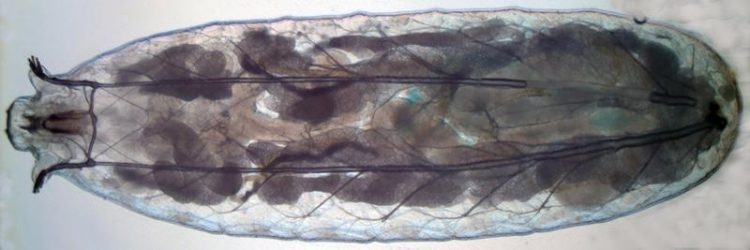Breaking Through Insect Shells at a Molecular Level

Light microscopy image of a live Drosophila that was unable to produce enough growth factor idgf6. Results are defects in the respiratory organ and in the chitinous shell. Photo: Dr. Matthias Behr
The same things that work with fruit flies (Drosophila) – one of developmental biologists’ favorite animals to study – can generally also be applied to other insects. The deactivation of chitinase 2 and/or idgf6 genes results in a fragile shell that does not support adequate protection for larva of fruit flies and very likely other insects such as mosquitos.
“Pathogens can then easily infiltrate the animals, and they usually die during the larval stage,” says Assistant Professor Dr. Matthias Behr, who transferred from the Life & Medical Sciences (LIMES) Institute at his alma mater in Bonn to the Sächsische Inkubator für die klinische Translation (SIKT) at the University of Leipzig. The project was financed with funding from Special Research Area 645 at the University of Bonn.
The objective: tailor-made inhibitors
The current discovery offers completely new starting points for keeping agricultural parasites as well as dangerous disease-carrying insects in check. The enzyme chitinase 2 and growth factor idgf6 are essential for shell formation in nearly all insects, as well as in arthropods like crabs and spiders.
“However, there are minor species-related differences that could allow us to develop tailor-made inhibitors that will prevent proper development of the chitinous shell in certain species,” says first author Yanina-Yasmin Pesch from the LIMES Institute at the University of Bonn. Specially developed substances could be used to attack the chitinous covering of one arthropod species while leaving other species unharmed.
Dr. Behr names two examples of possible applications: the spotted-wing drosophila (Drosophila suzukii) that recently migrated to Germany, and the new Zika virus pathogen. The spotted-wing drosophila causes enormous damage for the agricultural industry because it attacks a large volume of ripening fruit. The Zika virus is transmitted to people through mosquito bites. This virus is suspected of causing birth defects in Brazil, among other places. The researchers hope their discovery will make it easier to fight these kinds of dangerous insects in the future.
Supposed degradation enzyme helps build up shells
The researchers from the universities of Bonn and Leipzig, as well as from the Max Planck Institute of Biophysical Chemistry in Göttingen, turned up one other surprising find: “Until now, scientists assumed that chitinase 2 was a degradation enzyme,” reports Pesch. “But surprisingly, it has now been found that the enzyme is essential in forming the chitinous shell.” When the protective casing is being created, chitinase shortens the chitin to the right length. The precisely tailored components are then combined with other materials to build the shell.
As the team of researchers already showed in a previous study, the “Obstructor-A” protein plays a key role here. Like a construction-site manager, it makes sure that various building materials are added to the protective shell in the right places. “Step by step, our research is revealing molecular details about the insects’ Achilles heel,” says Dr. Behr.
Publication: Chitinases and Imaginal disc growth factors organize the extracellular matrix formation at barrier tissues in insects, professional journal “Scientific Reports”
Media contact:
Assistant Professor Dr. Matthias Behr
Sächsischer Inkubator für die klinische Translation (SIKT)
University of Leipzig
Tel. ++49-341-9739584
Email: matthias.behr@uni-leipzig.de
M.Sc. Yanina-Yasmin Pesch
Life & Medical Sciences (LIMES) Institute
University Bonn
Tel. ++49-228-7362713
Email: ypesch@uni-bonn.de
http://www.nature.com/articles/srep18340 Publication online
Media Contact
More Information:
http://www.uni-bonn.de/All latest news from the category: Life Sciences and Chemistry
Articles and reports from the Life Sciences and chemistry area deal with applied and basic research into modern biology, chemistry and human medicine.
Valuable information can be found on a range of life sciences fields including bacteriology, biochemistry, bionics, bioinformatics, biophysics, biotechnology, genetics, geobotany, human biology, marine biology, microbiology, molecular biology, cellular biology, zoology, bioinorganic chemistry, microchemistry and environmental chemistry.
Newest articles

Security vulnerability in browser interface
… allows computer access via graphics card. Researchers at Graz University of Technology were successful with three different side-channel attacks on graphics cards via the WebGPU browser interface. The attacks…

A closer look at mechanochemistry
Ferdi Schüth and his team at the Max Planck Institut für Kohlenforschung in Mülheim/Germany have been studying the phenomena of mechanochemistry for several years. But what actually happens at the…

Severe Vulnerabilities Discovered in Software to Protect Internet Routing
A research team from the National Research Center for Applied Cybersecurity ATHENE led by Prof. Dr. Haya Schulmann has uncovered 18 vulnerabilities in crucial software components of Resource Public Key…





















